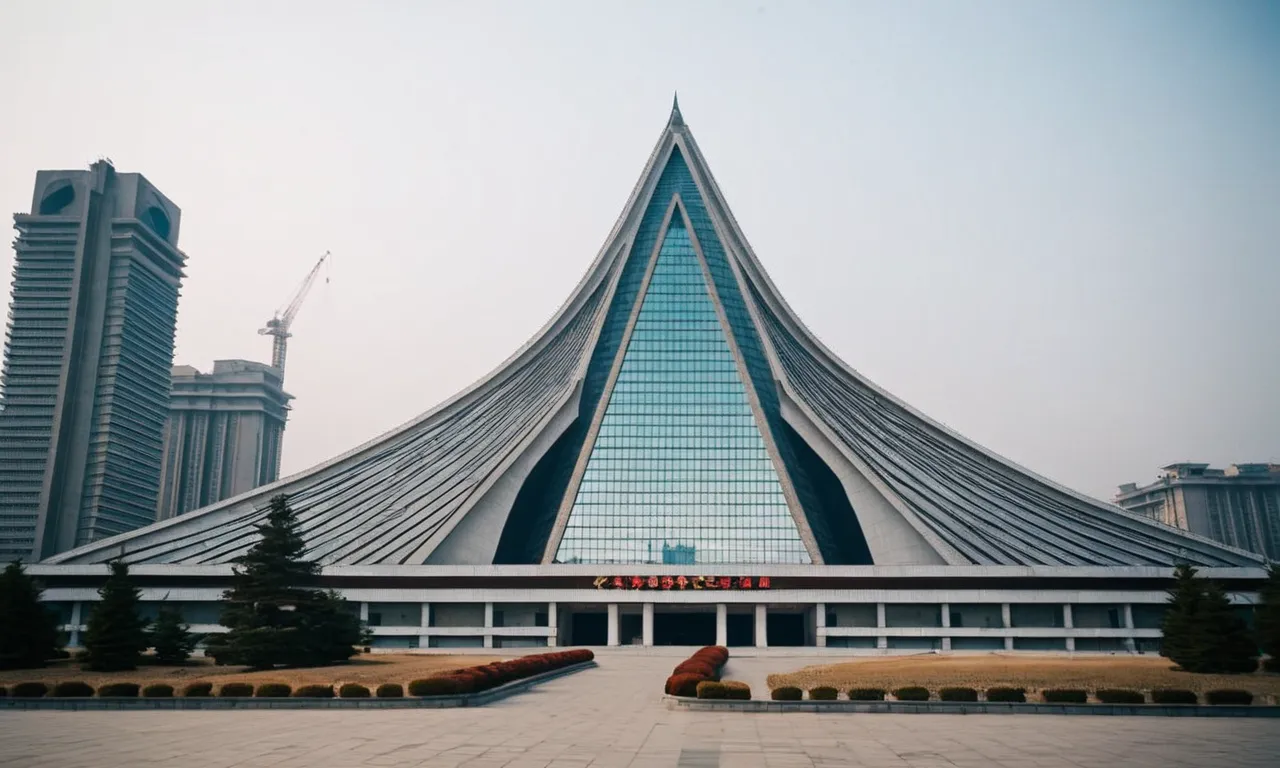Why Did The Ryugyong Hotel Fail? An In-Depth Exploration
The Ryugyong Hotel, a towering and enigmatic structure in the heart of Pyongyang, North Korea, has captured the imagination of the world for decades. This colossal edifice, once envisioned as a symbol of North Korea’s ambition and technological prowess, has become a haunting reminder of the country’s unfulfilled dreams and the challenges it has faced.
If you’re short on time, here’s a quick answer to your question: The Ryugyong Hotel failed due to a combination of economic sanctions, political turmoil, and technical challenges that plagued its construction from the outset.
In this comprehensive article, we will delve into the intricate history of the Ryugyong Hotel, exploring the factors that led to its downfall, the controversies surrounding its construction, and the potential future plans for this iconic structure.
We will examine the economic, political, and technological hurdles that North Korea faced, shedding light on the complexities of this ambitious project.
The Ambitious Vision: Ryugyong Hotel’s Origins
North Korea’s Aspirations for a Landmark Hotel
In the late 1980s, North Korea embarked on an ambitious project that aimed to showcase the nation’s technological prowess and cement its status on the global stage. The Ryugyong Hotel was envisioned as a towering symbol of North Korea’s aspirations, a colossal structure that would not only accommodate visitors but also serve as a landmark representing the country’s achievements.
The Architectural Marvel: Designed to Impress
The design of the Ryugyong Hotel was a true architectural marvel. Conceived by architects from the Baikdoosan Architects & Engineers firm, the hotel’s pyramidal shape and imposing height of 330 meters (1,083 feet) were meant to make it a striking addition to the Pyongyang skyline.
With a staggering 105 floors and a planned capacity of 3,000 rooms, the Ryugyong Hotel was poised to become one of the tallest hotels in the world at the time.
Construction Begins: Optimism and Challenges
Construction on the Ryugyong Hotel commenced in 1987 with great optimism and fanfare. North Korea, then under the leadership of Kim Il-sung, allocated significant resources to the project, which was initially slated for completion in 1989.
However, the ambitious undertaking soon faced numerous challenges, including economic difficulties, material shortages, and technological limitations.
Despite the obstacles, construction progressed, albeit at a slower pace than anticipated. By 1992, the exterior structure had been largely completed, towering over the Pyongyang skyline as a testament to the nation’s determination.
However, the project stalled shortly after, with a lack of funds and resources hampering further progress. According to reports, an estimated $750 million had been spent on the project by that point, a staggering sum for a country facing economic hardships.
Economic Sanctions and Financial Woes
The Impact of International Sanctions
One of the significant factors that contributed to the failure of the Ryugyong Hotel project was the economic sanctions imposed on North Korea by the international community. These sanctions, aimed at curbing the country’s nuclear and missile programs, severely restricted North Korea’s access to foreign capital, technology, and resources necessary for large-scale construction projects like the Ryugyong Hotel.
The sanctions made it extremely difficult for North Korea to import essential materials, equipment, and expertise, hampering the project’s progress and ultimately leading to its stagnation. According to UN Security Council Resolutions, North Korea faced strict financial restrictions, asset freezes, and trade embargoes, which exacerbated the country’s economic challenges.
North Korea’s Economic Struggles
North Korea’s struggling economy further compounded the challenges faced by the Ryugyong Hotel project. The country’s centralized, state-controlled economic system and isolation from the global market made it difficult to allocate sufficient resources and funding for the ambitious construction endeavor.
With a GDP of just $27.96 billion in 2021, according to estimates, North Korea struggled to prioritize the hotel’s completion amid other pressing economic and social needs. The lack of a robust private sector and foreign investment further hindered the project’s progress, as the government had to rely solely on its limited resources and state-owned enterprises.
Funding Challenges and Stalled Progress
The Ryugyong Hotel project’s ambitious scale and grandiose design required substantial financial investment, which North Korea found increasingly challenging to secure. The initial cost estimates were likely underestimated, and as construction progressed, unforeseen expenses and delays further strained the project’s budget.
North Korea’s inability to secure additional funding sources, either domestically or through international partnerships, ultimately led to the project’s stagnation. Construction was halted for over 16 years, from 1992 to 2008, as the country grappled with economic turmoil and prioritized other pressing needs.
Despite sporadic attempts to revive the project, the lack of consistent funding and resources proved to be an insurmountable obstacle, leaving the Ryugyong Hotel unfinished and a towering symbol of North Korea’s economic struggles.
Political Turmoil and Regime Changes
The Ryugyong Hotel’s stagnation and eventual failure can be attributed, in part, to the political upheaval and regime changes that North Korea experienced during its construction. The project, initially conceived as a symbol of the nation’s economic might and technological prowess, fell victim to shifting priorities and ideological shifts that accompanied leadership transitions.
Leadership Transitions and Shifting Priorities
The hotel’s construction began in 1987 under the leadership of Kim Il-sung, the founding father of North Korea. However, following his death in 1994, the project lost momentum as the new regime, led by Kim Jong-il, grappled with a series of economic crises and prioritized military spending over grandiose construction projects. As the country faced famine and energy shortages, resources were diverted away from the Ryugyong Hotel, leaving it in a state of limbo for nearly two decades.
The Influence of Ideology and Propaganda
North Korea’s political ideology and propaganda machine played a significant role in the hotel’s fate. The regime’s emphasis on self-reliance and the glorification of the Kim dynasty often took precedence over pragmatic economic decisions. The Ryugyong Hotel, initially envisioned as a symbol of North Korea’s technological prowess, became a source of embarrassment and a reminder of unfulfilled promises as it stood unfinished for years.
According to reports from 38 North, a website dedicated to analyzing North Korean affairs, the regime’s propaganda efforts shifted focus away from the stalled project, portraying it as a temporary setback rather than a failure.
Geopolitical Tensions and Isolation
North Korea’s isolation from the global community and its strained relationships with major powers also contributed to the hotel’s downfall. The country’s pursuit of nuclear weapons and its confrontational stance towards the West led to economic sanctions and limited access to foreign investment and expertise. This isolation made it challenging to secure the necessary resources, materials, and technical know-how to complete the ambitious project.
According to data from the World Bank, North Korea’s international trade and foreign direct investment levels have remained stagnant for decades, further hampering its ability to undertake large-scale construction projects like the Ryugyong Hotel.
Despite the hotel’s eventual completion in 2018, its troubled history serves as a testament to the profound impact that political turmoil, ideological shifts, and geopolitical tensions can have on ambitious architectural endeavors.
The Ryugyong Hotel stands as a 😐 reminder of the challenges faced by North Korea and the consequences of prioritizing political agendas over economic realities.
Technical Challenges and Construction Setbacks
Structural and Engineering Obstacles
The ambitious Ryugyong Hotel project faced numerous structural and engineering hurdles that ultimately contributed to its failure. From the outset, the sheer scale and height of the planned 105-story pyramid-shaped structure posed significant challenges.
Building a skyscraper of such magnitude in a country with limited experience in high-rise construction was a daunting task.
According to reports from The Guardian, the foundation and core structure were not designed to withstand the immense weight and lateral forces exerted by a building of this size. Engineers struggled to find solutions to stabilize the frame, leading to structural instability and safety concerns.
The lack of proper reinforcement and the use of substandard materials further compounded the engineering difficulties.
Lack of Expertise and Resources
North Korea’s isolation and limited access to advanced construction technologies and expertise played a significant role in the project’s downfall. The country lacked skilled labor and specialized engineers capable of undertaking a project of such magnitude.
As construction progressed, it became evident that the workforce lacked the necessary training and experience to tackle the intricate challenges posed by the Ryugyong Hotel.
Furthermore, the economic sanctions imposed on North Korea due to its nuclear program severely restricted the country’s ability to acquire essential materials and equipment from abroad. This shortage of resources, coupled with the nation’s limited domestic production capabilities, made it nearly impossible to secure the necessary construction supplies and cutting-edge technologies required for a project of this scale.
Safety Concerns and Abandoned Efforts
As the construction encountered numerous setbacks and delays, concerns over the safety and structural integrity of the Ryugyong Hotel grew. According to a report by the BBC, the project was halted in 1992 after the construction had reached the 60th floor, leaving the unfinished skeleton of the building exposed to the elements for over a decade. The prolonged exposure to harsh weather conditions, coupled with the lack of maintenance, further exacerbated the deterioration of the structure.
In the late 1990s, attempts were made to resume construction, but these efforts were short-lived due to the ongoing economic crisis and the government’s shifting priorities. By the early 2000s, the Ryugyong Hotel had become a symbol of North Korea’s unfulfilled ambitions, serving as a stark reminder of the country’s economic and technological limitations.
Despite the numerous challenges and setbacks, the Ryugyong Hotel remains an iconic, albeit unfinished, landmark in Pyongyang. Its towering presence serves as a testament to the ambitious dreams and the harsh realities faced by a nation grappling with isolation and limited resources.
The project’s failure highlights the importance of meticulous planning, access to expertise, and a stable economic foundation when undertaking large-scale construction endeavors.
Conclusion
The Ryugyong Hotel, once a symbol of North Korea’s ambition and technological prowess, has become a haunting reminder of the country’s unfulfilled dreams and the challenges it has faced. Its failure to reach completion is a testament to the complex interplay of economic sanctions, political turmoil, and technical challenges that have plagued the nation.
As we reflect on the Ryugyong Hotel’s journey, we are reminded of the importance of perseverance, adaptability, and international cooperation in realizing ambitious projects. While the future of this iconic structure remains uncertain, its story serves as a cautionary tale and a reminder of the obstacles that can arise when grand visions collide with harsh realities.







